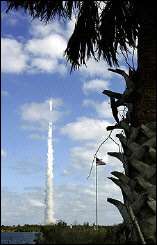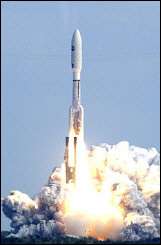New Horizons probe on its way to Pluto (Update)

A US space probe set off on a decade long mission to start an exploration of Pluto on the fringes of the solar system.
After launches were twice postponed this week because of bad weather and technical problems, an Atlas V-551 rocket blasted off from Cape Canaveral in Florida. The rocket and the probe separated on schedule 42 minutes later.
The New Horizons spacecraft will now travel at unparalleled speeds of up to 75,000 kilometers (47,000 miles) per hour toward Pluto.

Nine hours after liftoff, New Horizons was to pass by the moon. It took Apollo astronauts three days to reach the vicinity of the moon during their missions in the 1970s.
The craft, weighing 455 kilos (1,000 pounds) and the size of a small car, is scheduled to approach Pluto between July 2015 and July 2017.
It will spend six months orbiting Pluto and collecting data and pictures that will then take an estimated four hours and 25 minutes to be transmitted back to Earth.
NASA has again gone through a nervous wait to be able to launch one of its rockets.
On Tuesday, high winds at Cape Canaveral prevented the liftoff. Twenty-four hours later, a power failure at the Maryland laboratory managing the mission halted the launch.
Cloudy skies led to minor delays Thursday but did not trump the launch.
Had NASA failed to launch New Horizons by January 27, its trip to Pluto would have taken several more years.
NASA's launch timetable was built around a unique planetary alignment that would enable the gravitational force of Jupiter to sling the probe on at accelerated speeds, cutting about 30 months off the trip.
When New Horizons approaches Pluto, it will be about 4.9 billion kilometers (three billion miles) from Earth.
Scientists said the mission had to be carried out before 2020 because, after that date, Pluto, which has a lopsided, non-circular 248-year orbit, will be too far from the sun and its atmosphere will be frozen.
New Horizons will also send back information on Charon, Pluto's biggest moon, and two other satellites before heading further into space for five years probing the icy and rocky bodies of the Kuiper Belt.
Scientists hope the ambitious journey will help them better understand the origins of Earth and the other planets some 4.5 billion years ago.
Pluto was only discovered 75 years ago and there is now a debate about whether it should even be considered a planet. A growing number of astronomers say it is just a big asteroid.
Astronomers have discovered a number of objects similar to Pluto in the Kuiper belt surrounding the solar system.
But US experts consider the exploration of Pluto and the Kuiper belt to be one of the most important missions in space exploration.
New Horizons, which is costing 650 million dollars, was first proposed in 2001. Congress saved it in 2002 from spending cuts decided by President George W. Bush's administration.
© 2006 AFP















